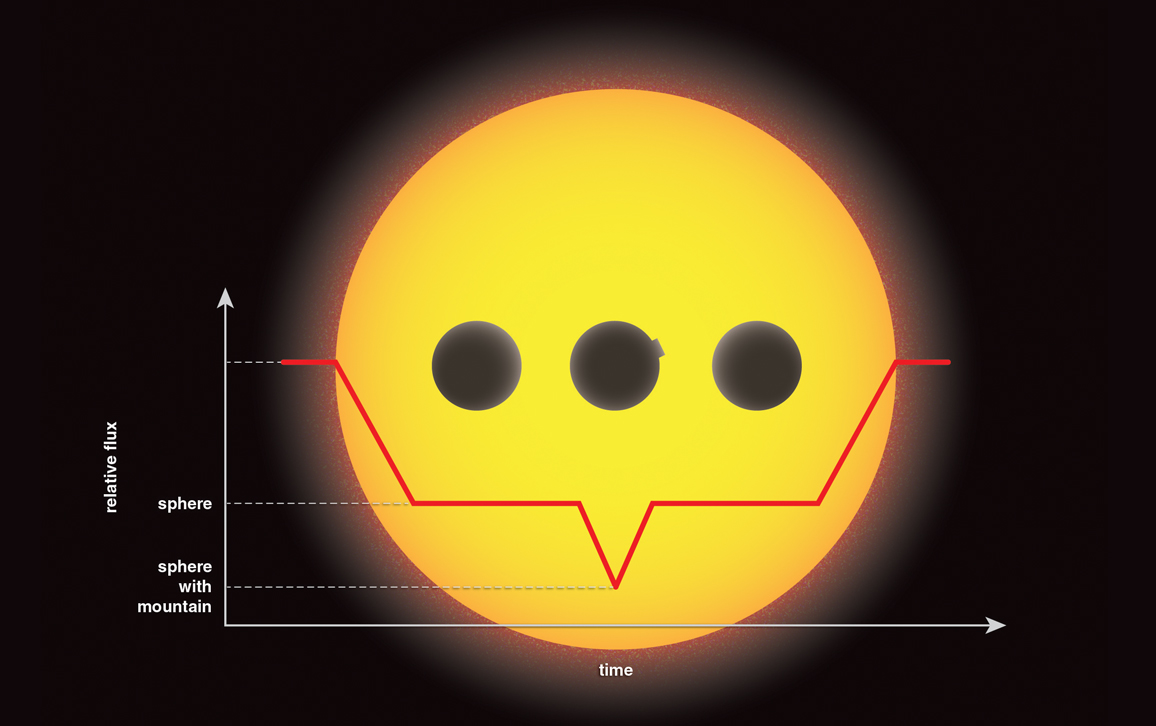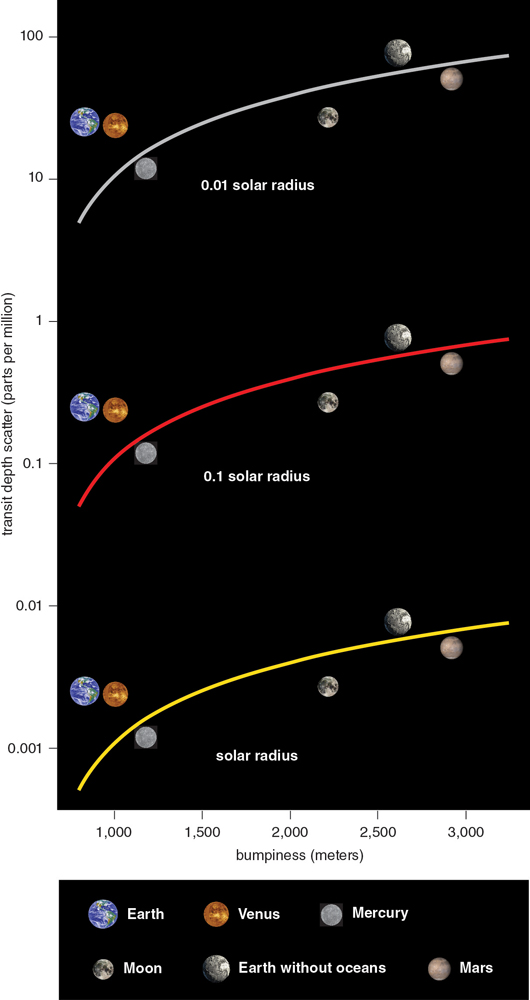Mapping Alien Worlds
By Moiya McTier
Data barely discernible from noise could tell us whether exoplanets have mountains.
Data barely discernible from noise could tell us whether exoplanets have mountains.

Nearly 20 years after the discovery of the first planet outside of our Solar System in 1992, NASA launched the Kepler spacecraft in 2009 with the express goal of finding more exoplanets. In the intervening years, we've learned that a lot of extrasolar planets (or exoplanets) are out there, but in most cases we know little more than their masses, diameters, and distances from their stars. We want to know what they are like as worlds. Astronomers have developed methods to characterize their atmospheres, surface reflectivity, and orbital eccentricities. Some ambitious researchers even came up with ways to detect plants, industrial pollution, and artificial night lights, all with the hope of detecting alien life. It turns out that we can begin to tease out more intimate details, even though we cannot observe these planets directly. No one had developed a method to characterize the texture of exoplanet surfaces—the mountains, volcanoes, and trenches that give a planet its shape, until my advisor David Kipping and I decided to see what it would take to detect topography on a planet outside of our Solar System.

Barbara Aulicino
The vast majority of confirmed exoplanets were discovered with a method called transit photometry. Using this method, astronomers are able to study the shadows that planets cast on their host stars—and therefore the planets themselves—by analyzing something called a transit light curve. This curve is a measure of how much light a telescope receives from a particular source over time. (For more on transit detection, see “What’s Next for Finding Other Earth-like Worlds?” in this issue.)
We believed that, as long as a planet was able to rotate as it moved in front of its star, the features sticking out on its surface (or its exotopography) would have a significant effect on the shape of its shadow, and thus on the shape of its transit light curve. We knew the effect would be small, and would have to be mined from the data buried within the scatter at the bottom of the light curve that most would consider noise, but we wanted to know exactly how small so that we could start planning future exotopographical observations.
Detecting the scatter in the light curve from bumpiness is as difficult as finding a single grey hair on someone’s head—if that person is on the Moon.
To see how planet topography would affect an observed transit light curve, we gathered real elevation data for the rocky bodies in our own Solar System: Mercury, Venus, Earth, the Moon, and Mars. Using that data, we simulated what a light curve would look like if we could observe these bodies transiting in front of a star without an atmosphere or any sources of noise. We ignored the atmospheres because they could either obscure or highlight topographical features depending on their composition; Venus, for example, has such a thick atmosphere that its shadow would likely present as a solid sphere. We then calculated the amount of scatter in the light curve that was caused by topography.
At the same time, we studied each body to get a measure of how mountainous, or “bumpy,” they are. This value, which we call bumpiness, is a measure of how much the height of the average topographical feature varies from the planet’s radius. Among the planets we studied, Mars is the bumpiest, with a bumpiness value nearly three times that of Earth. This value makes sense because Mars hosts the largest volcano in the Solar System, Olympus Mons, which stands about two and a half times the height of Mount Everest above sea level.

Barbara Aulicino
Once we had calculated both the bumpiness and light curve scatter for each planet, we derived an equation that takes scatter and host star radius as inputs and returns planet bumpiness. With this equation, astronomers won’t be able to identify individual mountains on exoplanets, but we will be able to say whether a given planet looks more like Kansas or Tibet.
Of course, mountains produce a very small effect on the transit light curve. The optimal system in which to detect bumpiness is that of a Mars-sized planet orbiting a white dwarf star, because the planet blocks a larger percentage of the small star’s light, so the features in the light curve are more exaggerated. Even under these conditions, the scatter in the light curve from bumpiness is only on the order of 100 parts per million. Detecting such a signal is as difficult as finding a single grey hair on someone’s head—if that person is on the Moon.
That kind of precision is just on the edge of current telescope capability, but the next generation of telescopes should be able to make these detections. We predict that we could have a confidant detection of planet bumpiness with fewer than 20 hours of observing time on the Overwhelmingly Large Telescope, which could come online in the next 10 years.
Although mountains aren’t directly responsible for creating environments suitable for hosting life, we can use them as a proxy for other planet characteristics that are more directly related to planet habitability. For example, mountains and volcanoes are consequences of tectonic plate movement and internal volcanism, which help sustain life by cycling harmful gases out of the atmosphere and providing a source of heat independent of the host star. The bumpier a planet is, the more confident we can be that it has tectonic plate movement and/or volcanism.
We still don’t know how atmospheres will affect our observations and we want to see whether this method can be used to detect oceans on exoplanets, so there is plenty more work to be done in the field of exotopography. Of course, if the goal is to find a habitable planet, more is needed than just information about the planet’s mountains, temperature, oceans, or compositions. But exotopography adds another element to the array of data-mining techniques we’ll use to understand which worlds are more likely to support life.
Click "American Scientist" to access home page
American Scientist Comments and Discussion
To discuss our articles or comment on them, please share them and tag American Scientist on social media platforms. Here are links to our profiles on Twitter, Facebook, and LinkedIn.
If we re-share your post, we will moderate comments/discussion following our comments policy.